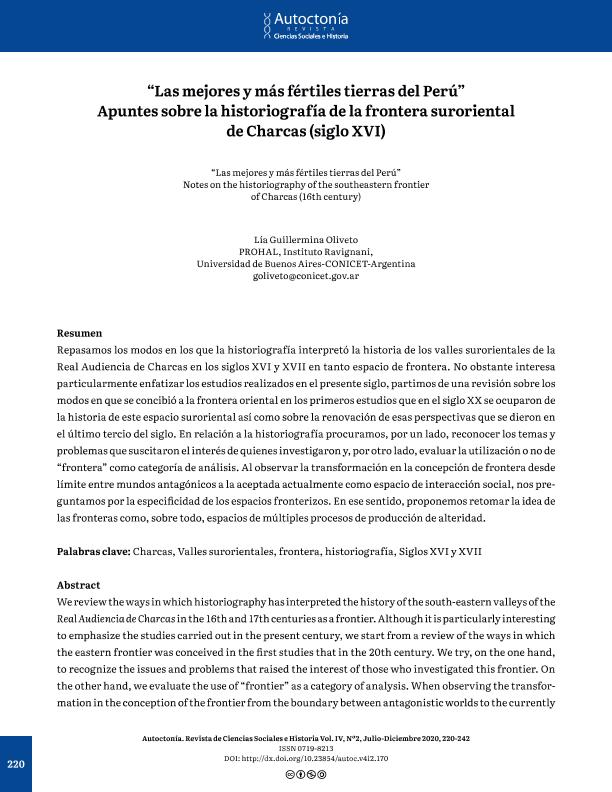Mostrar el registro sencillo del ítem
dc.contributor.author
Oliveto, Lia Guillermina

dc.date.available
2021-09-16T01:38:08Z
dc.date.issued
2020-07-31
dc.identifier.citation
Oliveto, Lia Guillermina; Las mejores y más fértiles tierras del Perú: Apuntes sobre la historiografía de la frontera suroriental de Charcas (siglo XVI); Universidad Bernardo O'Higgins; Autoctonía; 4; 2; 31-7-2020; 220-242
dc.identifier.issn
0719-8213
dc.identifier.uri
http://hdl.handle.net/11336/140462
dc.description.abstract
Repasamos los modos en los que la historiografía interpretó la historia de los valles surorientales de la Real Audiencia de Charcas en los siglos XVI y XVII en tanto espacio de frontera. No obstante interesa particularmente enfatizar los estudios realizados en el presente siglo, partimos de una revisión sobre los modos en que se concibió a la frontera oriental en los primeros estudios que en el siglo XX se ocuparon de la historia de este espacio suroriental así como sobre la renovación de esas perspectivas que se dieron en el último tercio del siglo. En relación a la historiografía procuramos, por un lado, reconocer los temas y problemas que suscitaron el interés de quienes investigaron y, por otro lado, evaluar la utilización o no de frontera como categoría de análisis. Al observar la transformación en la concepción de frontera desde límite entre mundos antagónicos a la aceptada actualmente como espacio de interacción social, nos preguntamos por la especificidad de los espacios fronterizos. En ese sentido, proponemos retomar la idea de las fronteras como, sobre todo, espacios de múltiples procesos de producción de alteridad.
dc.description.abstract
We review the ways in which historiography has interpreted the history of the south-eastern valleys of the Real Audiencia de Charcas in the 16th and 17th centuries as a frontier. Although it is particularly interesting to emphasize the studies carried out in the present century, we start from a review of the ways in which the eastern frontier was conceived in the first studies that in the 20th century. We try, on the one hand, to recognize the issues and problems that raised the interest of those who investigated this frontier. On the other hand, we evaluate the use of “frontier” as a category of analysis. When observing the transfor-mation in the conception of the frontier from the boundary between antagonistic worlds to the currently accepted definition as space of social interaction, we ask ourselves about the specificity of frontier spaces. In this sense, we propose to think in frontiers, as spaces of multiple processes of production of otherness.
dc.format
application/pdf
dc.language.iso
spa
dc.publisher
Universidad Bernardo O'Higgins
dc.rights
info:eu-repo/semantics/openAccess
dc.rights.uri
https://creativecommons.org/licenses/by-nc-sa/2.5/ar/
dc.subject
CHARCAS
dc.subject
VALLES SURORIENTALES
dc.subject
HISTORIOGRAFÍA
dc.subject
SIGLO XVI
dc.subject.classification
Historia

dc.subject.classification
Historia y Arqueología

dc.subject.classification
HUMANIDADES

dc.title
Las mejores y más fértiles tierras del Perú: Apuntes sobre la historiografía de la frontera suroriental de Charcas (siglo XVI)
dc.title
Las mejores y más fértiles tierras del Perú: Notes on the historiography of the southeastern frontier of Charcas (16th century)
dc.type
info:eu-repo/semantics/article
dc.type
info:ar-repo/semantics/artículo
dc.type
info:eu-repo/semantics/publishedVersion
dc.date.updated
2021-09-07T19:43:00Z
dc.journal.volume
4
dc.journal.number
2
dc.journal.pagination
220-242
dc.journal.pais
Chile

dc.journal.ciudad
Santiago
dc.description.fil
Fil: Oliveto, Lia Guillermina. Consejo Nacional de Investigaciones Científicas y Técnicas. Oficina de Coordinación Administrativa Saavedra 15. Instituto de Historia Argentina y Americana "Dr. Emilio Ravignani". Universidad de Buenos Aires. Facultad de Filosofía y Letras. Instituto de Historia Argentina y Americana "Dr. Emilio Ravignani"; Argentina
dc.journal.title
Autoctonía
dc.relation.alternativeid
info:eu-repo/semantics/altIdentifier/url/http://www.autoctonia.cl/index.php/autoc/article/view/170
dc.relation.alternativeid
info:eu-repo/semantics/altIdentifier/doi/https://doi.org/10.23854/autoc.v4i2.170
Archivos asociados
